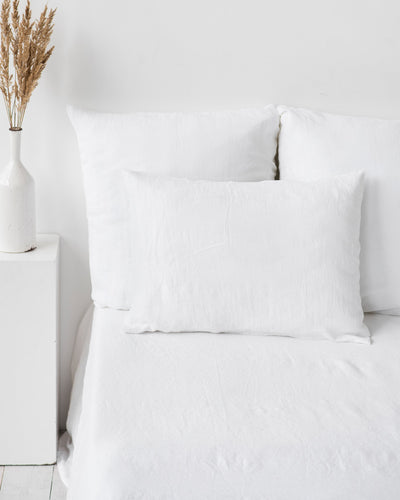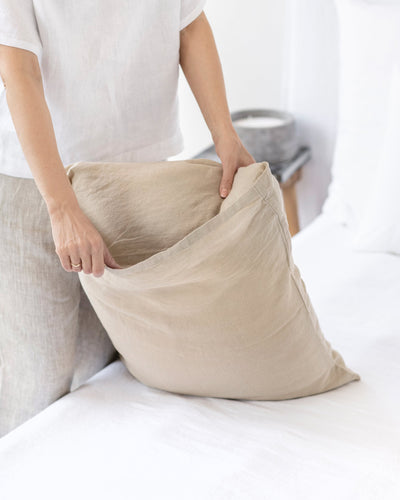How to Get Oil Out of Linen – Fast & Easy Stain Removal

If you've ever spilled oil on your favorite linen dress, you know the frustration of trying to get rid of that stubborn stain. But don’t worry—getting oil out of linen doesn’t have to be a challenge! With the right techniques and a few household items, you can quickly and easily remove oil stains from linen fabrics without ruining the quality.
In this guide, we’ll walk you through simple yet effective methods on how to get oil out of linen, ensuring your clothes look as good as new in no time.
Key Takeaways
-
Blot fresh oil stains immediately to prevent them from setting deep into the linen fabric.
-
Use dish soap for fresh stains, baking soda and vinegar for set-in stains, and lemon and sunlight for light-colored linen.
- For stubborn stains, try commercial stain removers, but always test them on a small area first.
How to Get Grease Out of Linen That Seem Difficult
Not all grease stains are the same - some can be super easy to remove, while others might require more patience and effort (especially if you notice them later).
Luckily, we have a step-by-step action plan for you on how to get the grease stains that are more stubborn than usual out of your favorite linen clothes:
- Remove grease from greasy linen laundry by following the stain removal instructions on the fabric's care label. The care instructions will tell you whether you should use cold, warm, or hot water. Remember to clean with plenty of zeal! Materials that can be exempt include those made of cotton, polyester, jersey, or linen.
- In case the stain is minimal, soak the fabric in a water-detergent solution, or wash it with club soda.
- In the event of an extreme stain, try sprinkling baking soda powder along with a few drops of vinegar directly on the stain. Afterward, blot the stained area with a clean paper towel to soak up the moisture.
How to Get Oil Stains and Grease Out of Linen
Also, not all linen cloth is the same. For example, some linen sheets are made of 100% natural linen, while others are mixed with some sort of synthetic materials. Also, there are a few types of linen fabric itself. Whether you want to know how to wash linen pants or how to wash linen curtains, keep reading to find out!


Immediate action - blot and absorb
When it comes to oil and grease stains, the sooner you act, the better the results will be. Blotting is the key to preventing the stain from setting deep into the fabric. Start by using a clean cloth, paper towel, or napkin to gently blot the stain—do not rub, as rubbing will push the oil further into the fibers. The goal is to absorb as much oil as possible.
If the stain is fresh, you can also sprinkle a little cornstarch, baby powder, or talcum powder on the area to soak up the excess oil before proceeding with further cleaning steps. Immediate action is essential, as letting the stain sit too long will make it harder to remove.
Dish soap method (best for fresh stains)
Dish soap is one of the simplest and most effective solutions for removing fresh oil stains from linen. Dish soap is specifically formulated to cut through grease and oils, making it an ideal choice for quick stain removal.
To use this method, dab a small amount of clear (colorless) dish soap directly onto the stain. Use a soft-bristled brush, toothbrush, or your fingers to gently rub the soap into the fabric, working in small circular motions.
Let it sit for about 5-10 minutes, then rinse with warm water. This method works best on fresh stains, as it helps break down the oil before it has a chance to set.
Baking soda & vinegar power combo (for set-in stains)
For oil stains that have already set in, a baking soda and vinegar combination can work wonders. Baking soda is mildly abrasive and will help lift the oil from the fabric, while vinegar acts as a natural degreaser.
To use this method, sprinkle baking soda directly onto the stain and then apply a few drops of vinegar. You'll notice some fizzing, which is a good sign that the two ingredients are working together. Let the mixture sit for about 10-15 minutes to allow it to penetrate the fabric.
Afterward, blot the area with a clean cloth to lift away the oil and residue. Rinse thoroughly with warm water and launder as usual. This combination is particularly effective for stains that have had time to settle in and become more difficult to remove.
Lemon & sunlight (for light-colored linen)
If you have light-colored linen, you can use a natural, eco-friendly method to treat oil stains: lemon and sunlight. Lemon juice acts as a natural bleach and degreaser, while sunlight helps lift the stain and naturally brightens the fabric. To use this method, apply fresh lemon juice directly onto the oil stain, then leave the garment in the sun for a few hours.
The combination of lemon juice and sunlight can help break down the oil while lightening the stain. This method works best for light-colored or white linen, as it could cause discoloration on darker fabrics. After the stain is treated, rinse the fabric in cold water and launder as usual.
Commercial stain removers (last resort for stubborn stains)
When all else fails, commercial stain removers designed for grease and oil stains can be your best friend. These products are specifically formulated to target tough stains and can be very effective on linen if used correctly.
To use a commercial stain remover, follow the instructions on the product label carefully. Usually, you will apply the remover directly to the stained area and let it sit for a specified amount of time before washing the garment.
Keep in mind that harsh chemicals can sometimes affect the integrity of linen, so always test the product on a small, inconspicuous area first. As a last resort, a commercial stain remover can help lift even the most stubborn oil and grease stains.
Using Dish Soap to Treat Grease Stains
When it comes to cleaning anything in the household - we always give preference to simple and cheap methods. The dishwashing method definitely falls into this category!
Dish soap works effectively on clothes made of cotton, linen, jersey, linen, and polyester fabrics. On your clothing you will find a care label with cleaning instructions indicating whether it is correct to use cold, lukewarm, or hot water to clean your garment; however, if you are washing clothing made of suede, leather, satin, velvet, or silk fabrics, the use of dish soap is not recommended.


The following steps will adequately guide you on how to use dishwashing liquid to treat grease stains on your laundry:
- Use a dry paper towel on the claimed area to soak up excess oil. This should be done with much alacrity to avoid any case of friction. Important: Act quickly - the sooner you notice the stain and start cleaning, the easier it will be to successfully remove it.
- Cover the stained area with normal soap. The dishwashing liquid should be colorless. By the way, you can also use a commercial stain remover or liquid detergent, as they accelerate the process of removing the stain.
- Take a toothbrush with soft bristles and start rubbing the stain covered with dishwashing liquid. Gently rub the grease stain on the clothes in circular motions with little pressure. This will help the soap to penetrate deeper into the fabric. Once you have done these steps, leave your clothes for 30 minutes to allow the soap to penetrate them.
- Rinse the soiled area thoroughly with hot, clean water to wash off the soap. If the water you use is hot, please use thick rubber gloves.
- The last step is to wash the clothes. But before that, you need to know the water temperature guidelines, and if there is none, it is best to use the hot water cycle.
Important: please note that improper use of any cleaning detergent or method may result in damaging your linen item. Make sure you always follow our official linen care guide carefully.
Conclusion
Whether it’s blotting up fresh stains, using dish soap for a quick fix, or relying on natural remedies like lemon and sunlight for lighter fabrics, these techniques are effective ways to clean your linen and remove those pesky oil stains.
However, one of the most important factors in ensuring your linen can be cleaned without harm is purchasing high-quality linen. Quality linen not only lasts longer but also holds up better against cleaning methods. So, when you invest in linen products, make sure you're choosing pieces that will stand the test of time.
Looking for beautiful, durable linen products? Whether it’s luxurious linen sheets, stylish linen dresses, or elegant linen curtains, MagicLinen offers premium linen collections perfect for your home and wardrobe.
Frequently Asked Questions (FAQs)
Do grease stains come out in the washing machine?
Yes, grease stains can come out in the washing machine, but it’s best to treat the stain first with dish soap or a stain remover. For set-in stains, a second wash may be needed.
Does olive oil come out of linen?
Yes, olive oil can be removed from linen. Act quickly by blotting the stain and applying dish soap or baking soda. For older stains, use a combination of baking soda and vinegar or a stain remover.
How do you get dried oil out of fabric?
To remove dried oil, apply dish soap, baking soda, or a stain remover to the stain. Let it sit, then wash it in warm water. Repeat if necessary, but avoid drying until the stain is gone.
What if the stain doesn’t come out after the first wash?
If the stain remains, don’t dry the fabric. Re-treat the stain with dish soap or stain remover and wash again. You may need to repeat the process until the stain is removed.
Can I use hot water to remove grease from linen?
Hot water can help, but use caution. Warm water is usually safer for linen to avoid damage. Always check the care label before using hot water on your garment.
 United States
United States

















